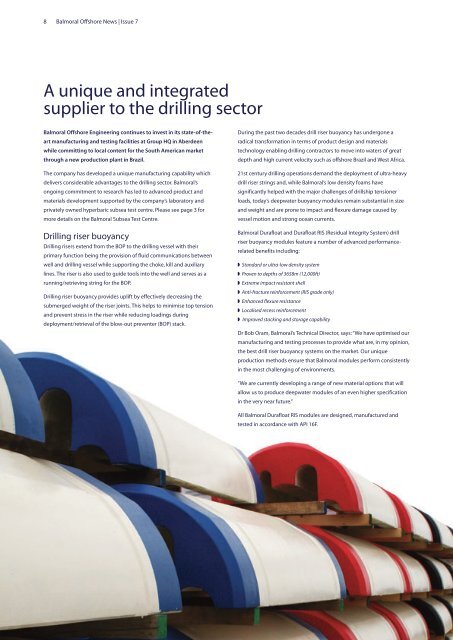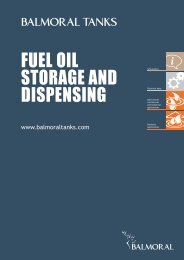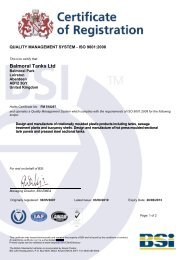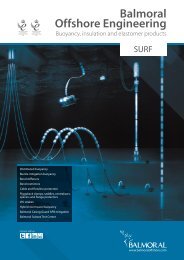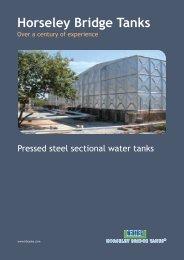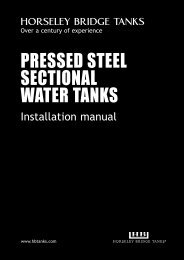BOE News issue 7 (PDF 1mb) - Balmoral Group
BOE News issue 7 (PDF 1mb) - Balmoral Group
BOE News issue 7 (PDF 1mb) - Balmoral Group
You also want an ePaper? Increase the reach of your titles
YUMPU automatically turns print PDFs into web optimized ePapers that Google loves.
8 <strong>Balmoral</strong> Offshore <strong>News</strong> | Issue 7<br />
A unique and integrated<br />
supplier to the drilling sector<br />
<strong>Balmoral</strong> Offshore Engineering continues to invest in its state-of-theart<br />
manufacturing and testing facilities at <strong>Group</strong> HQ in Aberdeen<br />
while committing to local content for the South American market<br />
through a new production plant in Brazil.<br />
The company has developed a unique manufacturing capability which<br />
delivers considerable advantages to the drilling sector. <strong>Balmoral</strong>’s<br />
ongoing commitment to research has led to advanced product and<br />
materials development supported by the company’s laboratory and<br />
privately owned hyperbaric subsea test centre. Please see page 3 for<br />
more details on the <strong>Balmoral</strong> Subsea Test Centre.<br />
Drilling riser buoyancy<br />
Drilling risers extend from the BOP to the drilling vessel with their<br />
primary function being the provision of fluid communications between<br />
well and drilling vessel while supporting the choke, kill and auxiliary<br />
lines. The riser is also used to guide tools into the well and serves as a<br />
running/retrieving string for the BOP.<br />
Drilling riser buoyancy provides uplift by effectively decreasing the<br />
submerged weight of the riser joints. This helps to minimise top tension<br />
and prevent stress in the riser while reducing loadings during<br />
deployment/retrieval of the blow-out preventer (BOP) stack.<br />
During the past two decades drill riser buoyancy has undergone a<br />
radical transformation in terms of product design and materials<br />
technology enabling drilling contractors to move into waters of great<br />
depth and high current velocity such as offshore Brazil and West Africa.<br />
21st century drilling operations demand the deployment of ultra-heavy<br />
drill riser strings and, while <strong>Balmoral</strong>’s low density foams have<br />
significantly helped with the major challenges of drillship tensioner<br />
loads, today’s deepwater buoyancy modules remain substantial in size<br />
and weight and are prone to impact and flexure damage caused by<br />
vessel motion and strong ocean currents.<br />
<strong>Balmoral</strong> Durafloat and Durafloat RIS (Residual Integrity System) drill<br />
riser buoyancy modules feature a number of advanced performancerelated<br />
benefits including:<br />
◗ Standard or ultra-low density system<br />
◗ Proven to depths of 3658m (12,000ft)<br />
◗ Extreme impact resistant shell<br />
◗ Anti-fracture reinforcement (RIS grade only)<br />
◗ Enhanced flexure resistance<br />
◗ Localised recess reinforcement<br />
◗ Improved stacking and storage capability<br />
Dr Bob Oram, <strong>Balmoral</strong>’s Technical Director, says: “We have optimised our<br />
manufacturing and testing processes to provide what are, in my opinion,<br />
the best drill riser buoyancy systems on the market. Our unique<br />
production methods ensure that <strong>Balmoral</strong> modules perform consistently<br />
in the most challenging of environments.<br />
“We are currently developing a range of new material options that will<br />
allow us to produce deepwater modules of an even higher specification<br />
in the very near future.”<br />
All <strong>Balmoral</strong> Durafloat RIS modules are designed, manufactured and<br />
tested in accordance with API 16F.


